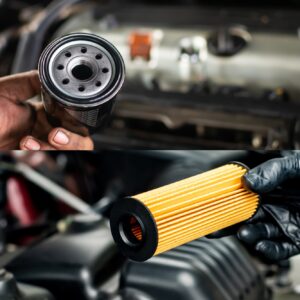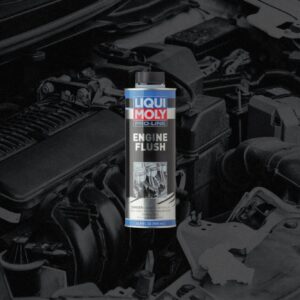Gone are the days when pulling out the dipstick was the only way to check the condition of your engine oil.
Today, vehicles that roll out of the factory are smart enough to know when an oil change is due, thanks to an oil life monitoring system hooked to their drivetrain.
What Is an Oil Life Monitoring System?
An oil life monitoring system is a set of sensors hooked to various parts of the drivetrain.
These sensors are responsible for collecting and sending information to the powertrain control module (PCM) about engine temperature, trip durations, and engine revolutions, among others.
First introduced by General Motors in the late ‘80s, the oil life monitoring system alerts drivers whenever their vehicles are due for an oil change without physically sampling the engine oil.
Once the oil life monitoring system identifies that a vehicle is due for an oil change, it will send the necessary data to the PCM, and the computer will trigger the “change oil” light or warning message.
How Does an Engine Oil Life Monitoring System Work?
An oil life monitoring system generally relies on electronic sensors to retrieve information on engine oil and vehicle conditions and sends data to the vehicle’s computer.
Most oil life monitoring systems track vehicle functions in the following ways.
Vehicle Mileage
Vehicle mileage tracking is the most common service monitoring system and arguably the simplest one.
When the vehicle reaches a certain number of miles since it was last reset, the control (vehicle computer) will activate the dash light stating that maintenance is needed.
Oil Life Computer Program
In newer vehicles, an oil life computer program helps determine the status of the engine oil. This program relies on the PCM to track the number of engine starts, outside temperature, and number of miles traveled, engine idling time in hours, among others.
The oil life computer program and PCM deduct numbers faster under certain driving conditions, particularly short stop-and-go driving. This is because such drives put more strain on the engine than long ones.
Most vehicles with an oil life computer program will have their oil life restored to 100% once the oil change warning light has been reset.
Oil Condition Sensor
Most oil life monitoring systems wouldn’t be complete without an oil condition sensor.
The oil condition sensor measures the oil’s dielectric properties. These properties tend to change upon exposure to water, soot, ash, and glycol.
Once the oil condition sensor is done measuring the engine oil’s properties, it sends all the information to the computer program to determine the appropriate time to trigger the “change oil” lamp.
How Reliable Is an Oil Life Monitoring System?
If you’ve been around enough electronics, you know very well that these things can fail at one point一sometimes at the most inconvenient time.
While electronics are generally reliable, there might come a time when people begin to lose trust in them once they malfunction.
The skepticism surrounding the reliability of oil life monitoring systems is quite understandable, and vehicle manufacturers are well aware of that.
Several experiments had to be conducted to ensure that oil life monitoring systems were doing their job.
For instance, the owner of a 2007 Honda Fit suspected that his vehicle was due for an oil change at 5,500 miles due to several out-of-town trips.
However, Honda’s Maintenance Minder–the automaker’s version of an oil life monitoring system–only alerted the driver at 7,600 miles after taking driving conditions into account.
After getting the oil changed, the used oil was sampled in a laboratory. The analysis revealed that when the monitoring system triggered the “change oil” lamp at 7,600 miles, the oil was still capable of delivering 2,000 more miles of service.
In another instance, a 2008 Pontiac G8 GT was monitored for the same reasons. Upon reaching the 13,000-mile mark, the vehicle alerted the driver that an oil change was due.
After sampling the used oil, the same laboratory revealed that the oil still had 2,000 miles of service life.
Tip from Richard McCuistian, ASE-certified Master Automobile Technician
It’s best to pay attention to the oil change intervals rather than trusting the oil change reminder. It’s not reliable in every case, and it’s better to be safe than sorry. One owner kept driving until his oil change reminder illuminated (GM GDI vehicle) and discovered he had driven 11,000 miles since his previous oil change. He wound up having to replace his camshaft for excessive wear. Learn from his experience.
Trust Your Vehicle’s Oil Life Monitoring System But Verify
Having an oil life monitoring system makes it easier for drivers to deal with various preventive maintenance tasks.
Tracking several mileage markers for fluid changes, tire rotations, and filter replacements can be too much to handle at times, so having an oil life monitoring system that automatically tells you that an oil change is due can be extremely convenient.
Oil monitoring systems across dozens of makes and models generally serve the same purpose, but they might differ in terms of how they display warnings and how to reset the oil life.
Be sure to read your owner’s manual to know more about your vehicle’s oil life monitoring system and how to work with it.
Automakers also tend to name their oil life monitoring systems differently. Some of the most common ones include:
- Chevrolet oil life monitoring system – Oil Life System (OLS)
- Dodge oil life monitoring system – Oil Change Indicator/Monitor
- Ford oil life monitoring system – Intelligent Oil Life Monitor
Limitations of a Typical Oil Life Monitoring System
As convenient as an oil life monitoring system is, it can only do so much. Below are some of its limitations.
Oil Level
A conventional oil life monitoring system doesn’t keep track of the amount of oil left in your engine.
Oil Quality
Some oil life monitors can’t distinguish between oil types. For instance, should you accidentally put vegetable oil in your engine instead of synthetic motor oil, the system won’t be able to measure oil quality and might not trigger the warning lamp or message.
How to Reset Your Oil Life Monitoring System
The right way to reset your oil life monitoring system greatly depends on your vehicle’s specifications.
In most cases, digital or analog controls to reset the system can be found on the dashboard.
Some vehicles require a manual resetting procedure, which involves depressing and releasing the accelerator pedal while the key is in the “ON” position.
Lastly, vehicles with complex electrical systems might require you to use an OBD-II scanner to reset the oil life system.
Any information provided on this Website is for informational purposes only and is not intended to replace consultation with a professional mechanic. The accuracy and timeliness of the information may change from the time of publication.

























